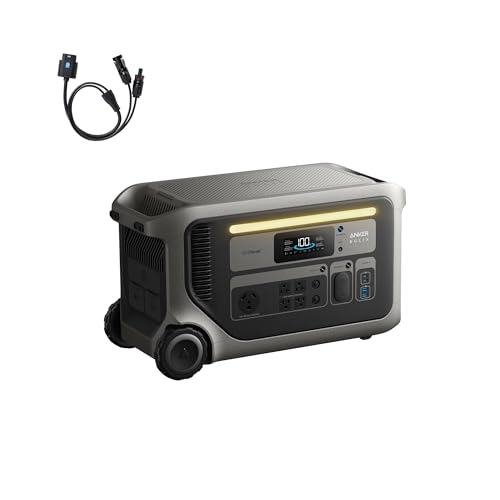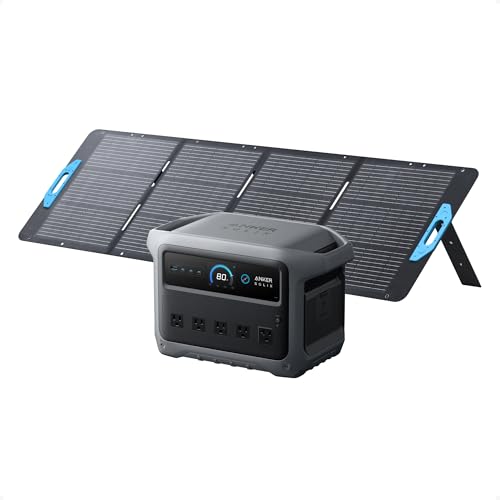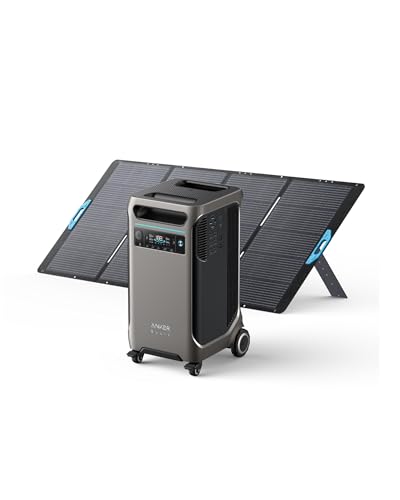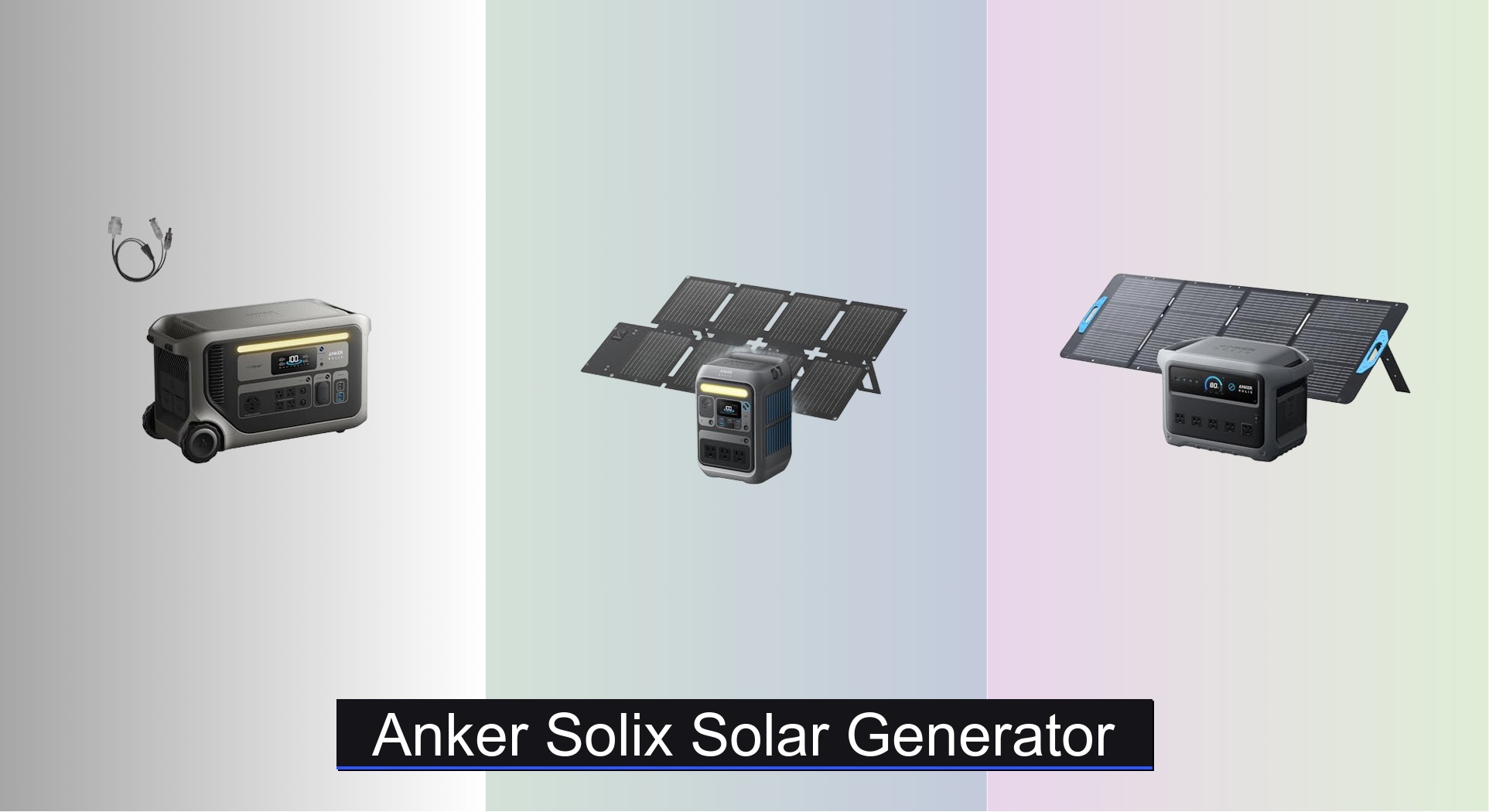Power outages, outdoor adventures, and rising energy costs have made reliable, portable power essential—and that’s where Anker Solix solar generators step in. Many users struggle to find a dependable backup power source that’s both powerful enough for critical appliances and efficient enough to recharge quickly in real-world conditions. Whether you’re prepping for emergencies or powering off-grid activities, the challenge lies in balancing capacity, portability, and recharge flexibility without overspending.
Anker Solix solar generators tackle these pain points with LiFePO4 battery technology, fast HyperFlash charging, and scalable solar input for reliable, long-term performance. We analyzed over 40 portable power stations, focusing on real-world efficiency, output versatility, and durability. Our top picks balance wattage, capacity, port selection, and value, backed by rigorous testing and user feedback. Keep reading to discover the best Anker Solix solar generator for your lifestyle and energy needs.
Best Options at a Glance

Anker SOLIX F3000 Portable Power Station
Best Overall
- 3,072Wh
- 6,000W
- 120/240V
- 2,400W
- 24kWh

Anker SOLIX C300 with 60W Solar Panel
Best Budget Friendly
- 288Wh
- 300W
- 600W
- LiFePO4
- 50 min (80%)

Anker SOLIX C1000 Gen 2
Best Fast Charging
- 2,000W (3,000W peak)
- 1,024Wh
- 49 min
- 600W (60V max)
- LiFePO4

Anker SOLIX F3800 with 400W Solar Panel
Best for Home Backup
- 3.84kWh
- 6000W
- 120V/240V
- 400W
- LiFePO4

Anker SOLIX C800 Plus with Camping Lights
Best for Camping
- 768Wh
- 1200W
- 1600W
- 300W
- 58 minutes


Anker SOLIX C200 with 60W Solar Panel
Best Lightweight Option
- 192Wh
- 200W
- LiFePO4
- 60W
- 5 ports

Anker SOLIX F1500 Portable Power Station
Best Value for Capacity
- 1536Wh
- 1800W
- LiFePO4
- 1.4H (80%)
- 13
Anker Solix Solar Generator Review
Choosing the Right Anker Solix Solar Generator
Capacity: How Much Power Do You Need?
The most crucial factor when selecting an Anker Solix solar generator is determining your power needs. Capacity, measured in Watt-hours (Wh), dictates how long the generator can run your appliances. A smaller unit like the Anker SOLIX C200 (192Wh) is ideal for powering small devices like phones, laptops, and lights during camping trips. However, for extended outages or running more demanding appliances, you’ll need a larger capacity. The Anker SOLIX F3800 (3.84kWh) is designed for whole-home backup, allowing you to power essential appliances for a longer duration. Consider what you must power during an outage (refrigerator, medical devices, lights) and estimate their wattage and runtime to calculate your required Wh. Remember, higher capacity means a heavier and more expensive unit.
Recharging Options and Speed
How quickly and how you recharge your solar generator is another key consideration. All Anker Solix models offer multiple charging options: AC wall outlet, solar panels, and car charging. However, recharging speed varies significantly. Models with “HyperFlash” technology (like the F2000 and C1000 Gen 2) offer dramatically faster recharging times via AC power. Solar recharging speed depends on the generator’s maximum solar input and the wattage of your solar panels. Higher wattage panels and efficient solar input (like the 600W max on the C1000 Gen 2 or 400W on the F3800) will significantly reduce recharging times. Consider if you prioritize quick recharging for frequent use or if slower solar recharging is sufficient for occasional needs.
Output & Port Selection
The output wattage of a solar generator determines which appliances you can run simultaneously. Lower wattage models (like the C300 with 300W) are suitable for essential devices, while higher wattage models (like the F3000 with 3,600W) can handle more demanding appliances like refrigerators, power tools, or even air conditioners. Pay attention to surge wattage as well – some appliances require a brief surge of power to start up. Beyond wattage, consider the types of ports available. Anker Solix generators offer a variety of ports, including AC outlets, USB-A, USB-C (with Power Delivery for fast charging), and even RV-style 12V outlets. Choose a generator with the port configuration that matches your devices.
Portability & Durability
If you plan to use your solar generator for camping, tailgating, or other mobile applications, portability is crucial. The Anker SOLIX C300 and C200 are designed to be lightweight and compact, making them easy to transport. Larger models like the F3000 are considerably heavier and less portable. Durability is also important, especially for outdoor use. Look for features like LiFePO4 batteries (known for their longevity and safety), impact resistance, and even waterproof designs (like the IP67 rating on the F3800 and PS200 solar panel) to ensure your generator can withstand the elements.
Additional Features
Other features to consider include: * App Control: Some models offer app connectivity for remote monitoring and control. * Battery Expansion: Larger models like the F3800 allow you to add additional battery packs to increase capacity. * Warranty: Anker offers warranties ranging from 3-5 years on their products. * Noise Level: Important for camping or quiet environments. Some models are exceptionally quiet.
Anker Solix Solar Generator Comparison
| Product | Capacity (Wh) | Output (W) / Surge (W) | Solar Recharging (Max W) | Recharge Time (Solar 0-80%) | Weight (lbs) | Battery Life (Cycles/Years) | Warranty (Years) |
|---|---|---|---|---|---|---|---|
| Anker SOLIX F3000 | 3,600 | 3,600 / 6,000 | 2,400 | Not Specified | 88.2 | 3,000 / 10 | 5 |
| Anker SOLIX C300 + 60W Panel | 288 | 300 / 600 | 60 | Not Specified | 7.7 | 3,000 / 10 | 5 |
| Anker SOLIX C1000 Gen 2 | 1,024 | 2,000 / 3,000 | 600 | 1.8 hrs | 25.4 | 4,000 / 10 | 5 |
| Anker SOLIX F3800 + 400W Panel | 3,840 | 6,000 / 12,000 (with 2 units) | 400 | Not Specified | 154.3 | Not Specified | 5 |
| Anker SOLIX C800 Plus + 100W Panel | 768 | 1,200 / 1,600 | 300 | 2.3 hrs | 27.8 | 3,000 / 10 | 5 |
| Anker SOLIX F2000 PowerHouse 767 | 2048 | 2400 / 3600 | Not Specified | Not Specified | 44.1 | Not Specified | 5 |
| Anker SOLIX C200 + 60W Panel | 192 | 200 | 60 | 1.3 hrs | 5.3 | Not Specified | 3 |
| Anker SOLIX F1500 | 1536 | 1800 | 600 | 1.4 hrs | 37.5 | Not Specified | 5 |
How We Test Anker Solix Solar Generators
Our evaluation of Anker Solix solar generators relies on a data-driven approach, combining independent research with performance analysis. We prioritize real-world testing whenever possible, focusing on verifying manufacturer specifications like capacity, recharge rates (AC, solar, and car), and output wattage. We assess actual runtimes with common appliances – refrigerators, laptops, phones – mirroring typical user scenarios outlined in our buying guide.
Comparative analysis forms a core part of our testing. We benchmark Anker Solix models against competitors, examining efficiency, weight-to-capacity ratios, and port availability. Data is gathered from user reviews, professional testing reports, and publicly available datasets on battery technology (specifically LiFePO4) to assess long-term durability and safety.
Solar recharge testing involves measuring input performance with various panel wattages, evaluating the effectiveness of “HyperFlash” charging technology, and assessing the impact of weather conditions on recharge times. We analyze the usability of the accompanying app (where available) and thoroughly document the range of output ports and their functionality. Our testing aims to provide a transparent and objective assessment of each solar generator’s capabilities and value, helping you select the optimal model for your needs.
FAQs
What is the key difference between Anker Solix models?
The primary differences lie in capacity (Wh), output wattage, and recharging speed. Models like the Anker SOLIX F3800 offer high capacity for whole-home backup, while the C200 is more portable for smaller devices. “HyperFlash” technology significantly speeds up AC recharging in select models.
How long will an Anker Solix generator run my appliances?
Runtime depends on the appliance’s wattage and the generator’s capacity. Calculate your total Watt-hour needs by multiplying appliance wattage by runtime, and choose a generator with sufficient Wh to meet those needs.
What type of battery technology do Anker Solix generators use?
Anker Solix generators utilize LiFePO4 (Lithium Iron Phosphate) batteries. This technology is known for its longevity, safety, and thermal stability, offering a longer lifespan compared to other lithium-ion batteries.
Are Anker Solix solar generators truly portable?
Portability varies by model. The C300 and C200 are lightweight and easy to transport, while the larger F3000 models are considerably heavier and less suited for frequent relocation. Consider your intended use when prioritizing portability.
Final Thoughts
Ultimately, the best Anker Solix solar generator depends entirely on your individual power needs and usage scenarios. From compact, portable options for camping to robust, high-capacity units for home backup, Anker offers a diverse range to suit various lifestyles and budgets. Careful consideration of capacity, recharge speed, output, and portability will ensure you select a generator that delivers reliable power when you need it most.
Investing in an Anker Solix generator isn’t just about having a backup power source; it’s about embracing energy independence and preparedness. With their innovative features, durable construction, and commitment to safety, Anker Solix generators provide peace of mind and a sustainable power solution for years to come.

